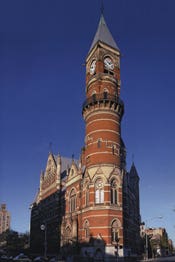
Features
Book Review: New York City Landmarks


As an Amazon Associate, we earn from qualifying purchases made through affiliate links.
New York City Landmarks
by Francis Morrone, photos by Jake Rajs
Antique Collectors' Club, New York, NY; 2012
236 pp; hardcover 240 color photos; $17.95
ISBN: 978-1-85149-669-3
If you are a fan of Times Square, the Chrysler Building or any of the other numerous landmarks in New York City, this new book belongs in your library. It offers photos and information on 76 of the city's most famous landmarks, with information by noted architectural historian Francis Morrone accompanying striking four-color images by Jake Rajs. Many of the images are gatefolds, creating panoramic views.
Morrone has written other New York City-oriented books, including An Architectural Guidebook to Brooklyn and An Architectural Guidebook to New York City, and he collaborated with Henry Hope Reed to write The New York Public Library: The Architecture and Decoration of the Stephen A. Schwarzman Building, reviewed by Clem Labine in our December, 2011 issue
When he is not writing, Morrone teaches at New York University's School of Continuing and Professional Studies and also leads architectural walking tours of New York City for the Municipal Art Society of New York.
New York City-based photographer Jake Rajs has specialized in commercial and art photography in his 40-year career. He has contributed to more than 15 art books and has been featured in publications such asTime, Life, Newsweek, The New York Times, and Town & Country.
The two have combined to create an attractive reference book that would be useful to anyone with an interest in architecture and who lives in New York City or visits Gotham.
In his preface, Rajs states: "New York is always changing, reinventing itself. In my books, I try to capture something that has not been created before." He concludes: "Enjoy the pictures and words, go out, and explore this inspirational city!"
The Table of Contents, a list of the landmarks that are included, is followed by maps of Manhattan showing where they are located. The book embraces both historical locations such as the Statue of Liberty and Warren & Wetmore's New York Yacht Club as well as newer landmarks, such as Ground Zero, the IAC Building by Frank Gehry and 100 Eleventh Avenue by Jean Nouvel. The entry for Cooper Union includes information and photos of the original 1853-59 building by Frederick A. Peterson along with information and a photo of the new Modernist building by Thom Mayne.
The book progresses in a geographical manner.
The reader's journey begins at the Statue of Liberty and Ellis Island and moves up the Manhattan grid. Sixty-seven of the landmarks covered are in Manhattan and another nine are in other boroughs. Each entry lists the name of the location, when it was built and the name of the original architect as well as other architects who might have contributed to the building over the years, and then includes a page or two of information.
The 236-page book is chock full of information, including history. For example, "On April 18, 1912, the Cunard liner RMS Carpathia pulled into Pier 59, at West 19th Street in the great Chelsea Piers complex, to deposit the lifeboats that had held the survivors of the RMS Titanic, which had so spectacularly sunk three days before on its maiden voyage from Southampton, England." Chelsea Piers was originally built in 1902-07 and extends from West 17th to West 23rd Streets.
Another example, "The legendary Apollo Theater on 125th Street, the main commercial crosstown thoroughfare of Harlem, opened in 1914 as Hurtig & Seamon's New Burlesque Theater, one among a number of theaters that had made Harlem a center for burlesque."
In some cases, the book reviews areas instead of specific buildings. "Chinatown," "Soho Cast Iron District," "Lower East Side: Tenement Museum, Eldridge Street Synagogue, Katz's Delicatessen" and "Riverside Park" describe these neighborhoods. The final landmark mentioned, for example, is "Verrazano-Narrows Bridge & Marathon," with a stunning aerial photo of the bridge filled with runners and another sunset view. This last image folds out to reveal the two-page "Index of Architects, Designers and Engineers."
This is an informative and attractive book about architecture – both old and new – and New York City. It is not a history that would be read cover to cover, but it is a useful reference guide. I would have liked to have seen more non-Manhattan landmarks, but perhaps that is a subject for another book. The size (8 in. tall x 6 in.) means it's not a typical coffee-table book, but the quality of the images and the text certainly puts it into that category. The smaller size does make it more convenient to carry when you are touring the city's architectural wonders.









